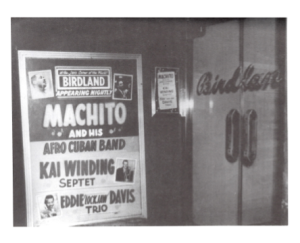Rhythms Without Borders: The Pan-American Innovation of Jazz
An Online Digital Humanities Project and Resource
Mambo: Jazz or Something Like It?
The best examples that demonstrate the reversal of the relationship between jazz and Latin music are “Tanga” and “Mambo Inn.” [Click on the links to hear those songs] The influence of swing era jazz on “Tanga” is clearly seen in the instrumentation of the horn section. The way in which Bauzá arranges both the trumpets and saxophones, blending both the woodwinds and brass to make a wall of sound, is a derivative of swing jazz compositions and practices. “Mambo Inn” retains many of the same, but features a darker, less pronounced percussion section giving way to a blaring horn section.
While it is obvious that Bauzá has blended two compatible styles, just as earlier jazz composers had done before, he has done so in such a new manner that includes Latin percussion in an authentic manner, which sets off Bauza’s work with Machito and His Afro-Cubans off from earlier incarnations of Latin Jazz, such as Juan Tizol’s “Caravan.” The lasting influence of this style are seen in later performances of Bauzá’s work by other prominent jazz artist and the seeking of authentically Latin arrangements by later artists.
Another important influence Machito and His Afro-Cubans had on the jazz world were their acceptance by 52nd Street and the Jazz Community as a whole. The top billing at the Birdland, a prominent jazz club on Broadway, just north of West 52nd Street, a jazz club haven, demonstrates a legitimacy of a Latin musical style within the realms of jazz (see posters above). What this does is it further entrenches the almost incestuous relationship connection between jazz and Latin style inflections of it. It is almost as if Latin jazz finally has an outwards sign of it’s prominence and importance within the genre. This also demonstrates a shift in audience expectations when it comes to jazz performance and the songs that they pick for the program. A great example of this is Count Basie’s inclusion of a version of “Mambo Inn” on his 1956 album, April in Paris. The interpretation is far more straight ahead than the original by Machito and His Afro-Cubans, however, that it is even included at all in an album standard jazz arrangements speaks volumes about public expectations as it pertains to jazz: audiences are expecting to hear a Latin number or two when they attend a concert or listen to a record. What this demonstrates is that Latin articulations of jazz have become so much a part of the system that has slowly become vital to its presentation.
This 1962 recording of “Mambo Inn” on Grant Green’s album The Latin Bit release by Blue Note Records, like the Count Basie cover, illustrates the continued importance of Latin styles in jazz even until the 60s.
[1] Boggs, Vernon. Salsiology:Afro-Cuban Music and the Evolution of Salsa in New York City. “The Cheetah: Pictorial Essay.” Birdland. New York: Greenwood Press, 1992. 42,43.


